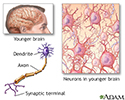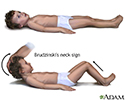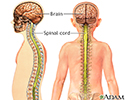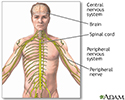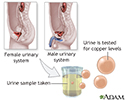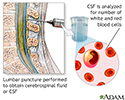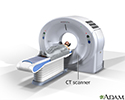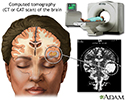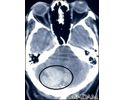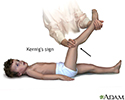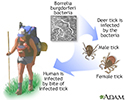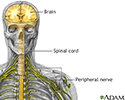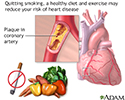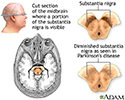Multimedia Gallery
Brain components
The brain is composed of more than a thousand billion neurons. Specific groups of them, working in concert, provide us with the capacity to reason, to experience feelings, and to understand the world. They also give us the capacity to remember numerous pieces of information.
There are three major components of the brain. The cerebrum is the largest component, extending across the top of the head down to ear level. The cerebellum is smaller than the cerebrum and located underneath it, behind the ears toward the back of the head. The brain stem is the smallest and is located under the cerebellum, extending downward and back toward the neck.
The cerebral cortex is the outside portion of the cerebrum, also called the “gray matter”. It generates the most complex intellectual thoughts and controls body movement. The cerebrum is divided into left and right sides, which communicate with each other through a thin stalk of nerve fibers. The grooves and folds increase the cerebrum’s surface area, allowing us to have a tremendous amount of gray matter inside of the skull.
The left side of the brain controls the muscles on the right side of the body and vice versa. Here, the left side of the brain is highlighted to show the control over right arm and leg movement, and the right side of the brain is highlighted to show the control over left arm and leg movement.
Voluntary body movements are controlled by a region of the frontal lobe. The frontal lobe is also where we shape emotional reactions and expressions
There are two parietal lobes, one on each side of the brain. The parietal lobes are located behind the frontal lobe towards the back of the head and above the ears. The taste center is located in the parietal lobes.
All sounds are processed in the temporal lobe. They are also important for learning, memory, and emotion. The occipital lobe is located at the back of the head behind the parietal and temporal lobes.
The occipital lobe analyzes visual information from the retina and then processes that information. If the occipital lobe becomes damaged, a person could become blind, even if his or her eyes continue to function normally
The cerebellum is located at the back of the head underneath the occipital and temporal lobes. The cerebellum creates automatic programs so we can make complex movements without thinking.
The brain stem is located underneath the temporal lobes and extended down to the spinal cord. It is critical for survival because it connects the brain with the spinal cord. The top portion of the brainstem is called the midbrain. The midbrain is a small portion of the brain stem located at the top of the brain stem. Just below the midbrain is the pons, and below the pons is the medulla. The medulla is the part of the brain stem closest to the spinal cord. The medulla, with its critical functions, lies deep within the head, where it is well-protected from injuries by an extra-thick section of overlying skull. When we are asleep or unconscious, our heart rate, breathing and blood pressure continue to function because they’re regulated by the medulla.
And that concludes a general overview of the components of the brain.
Brain components
Review Date: 4/1/2025
Reviewed By: Linda J. Vorvick, MD, Clinical Professor, Department of Family Medicine, UW Medicine, School of Medicine, University of Washington, Seattle, WA. Also reviewed by David C. Dugdale, MD, Medical Director, Brenda Conaway, Editorial Director, and the A.D.A.M. Editorial team.
Animations
- Alzheimer disease
- Alzheimer disease
- Asperger syndrome
- Atherosclerosis
- Athetosis resulting from ba...
- Attention deficit hyperacti...
- Autism spectrum disorders
- Bladder function - neurolog...
- Brain components
- Cerebral aneurysm
- Cerebral palsy
- Cholesterol and triglycerid...
- Cluster headache
- Concussion
- Concussion
- Diabetes
- Epilepsy
- Epinephrine and exercise
- Erection problems
- Essential hypertension
- Feeling pain
- Hardening of arteries
- Head injury
- Herniated disk
- Herniated nucleus pulposus ...
- How to use a pill cutter
- Hypertension - overview
- Insomnia
- Migraine
- Multiple sclerosis
- Neck pain
- Nerve conduction
- Parkinson disease
- Sciatica
- Seizures
- Shingles
- Sleep disorders
- Spinal stenosis
- Stroke
- Stroke
- Stroke - secondary to cardi...
- Systemic lupus erythematosus
- Tension headache
- Understanding cholesterol r...
- Urinary incontinence
Illustrations
- 15/15 rule
- Active vs. inactive muscle
- Acupuncture
- Adult dermatome
- Alcoholic neuropathy
- Alpha-glucosidase inhibitors
- Alzheimer disease
- Amebic brain abscess
- Amyloidosis of the fingers
- Arterial plaque build-up
- Arterial tear in internal c...
- Arteries of the brain
- Atherosclerosis
- Atherosclerosis of internal...
- Autonomic Nerves
- Balance receptors
- Before and after hematoma repair
- Bicycle helmet - proper usage
- Biguanides
- Blood pressure
- Blood pressure check
- Blood test
- Blood test
- Bone graft harvest
- Brain
- Brain
- Brain and nervous system
- Brain herniation
- Brain structures
- Brain wave monitor
- Brainstem function
- Brudzinski's sign of meningitis
- Calories and fat per serving
- Carotid dissection
- Carotid duplex
- Carotid stenosis - X-ray of...
- Carotid stenosis - X-ray of...
- Carpal tunnel surgical procedure
- Carpal tunnel syndrome
- Cataract - close-up of the eye
- Cauda equina
- Cause of headaches
- Causes of secondary headache
- Central nervous system
- Central nervous system
- Central nervous system and ...
- Cerebellum - function
- Cerebral aneurysm
- Cerebral aneurysm
- Cerebrospinal fluid leak
- Cervical spondylosis
- Cervical vertebrae
- Cholesterol
- Cholesterol producers
- Circle of Willis
- Common peroneal nerve dysfu...
- Complex carbohydrates
- Compression fracture
- Compression of the median nerve
- Concussion
- Congenital toxoplasmosis
- Copper urine test
- Coronary artery blockage
- Craniotomy for cerebral shunt
- Creutzfeldt-Jakob disease
- Crossed eyes
- CSF cell count
- CSF chemistry
- CSF protein test
- CT scan
- CT scan of the brain
- Damaged axillary nerve
- DASH diet
- Developmental process of at...
- Diabetes and exercise
- Diabetes and nerve damage
- Diabetic blood circulation ...
- Diabetic emergency supplies
- Diabetic retinopathy
- Ear anatomy
- Effects of age on blood pressure
- Electromyography
- Endarterectomy
- Endocrine glands
- Enlarged view of atherosclerosis
- Exercise can lower blood pr...
- External and internal eye a...
- Eye
- Eye ultrasound
- Facial drooping
- Femoral nerve damage
- Fibromyalgia
- Fish in diet
- Food and insulin release
- Forward bend test
- Glaucoma
- Glossopharyngeal neuralgia
- Glucose in blood
- Glucose test
- Grand mal seizure
- Gray and white matter of th...
- Haemophilus influenzae organism
- Head injury
- Head trauma
- Headache
- Healthy diet
- Herniated disk repair
- Herniated lumbar disk
- Herniated nucleus pulposus
- Herpes zoster (shingles) - ...
- Herpes zoster (shingles) di...
- Herpes zoster (shingles) on...
- Herpes zoster (shingles) on...
- Herpes zoster (shingles) on...
- Herpes zoster (shingles) on...
- Herpes zoster (shingles) on...
- Herpes zoster (shingles) on...
- Herpes zoster (shingles) on...
- High blood pressure tests
- Hunger center in brain
- Hypothalamus
- Increased intracranial pressure
- Indications of head injury
- Insulin production and diabetes
- Insulin pump
- Insulin pump
- Intervertebral disk
- Intracerebellar hemorrhage ...
- Intracerebral hemorrhage
- Intracranial pressure monitoring
- Irregular sleep
- Kernig's sign of meningitis
- Kyphosis
- Late-stage syphilis
- Left cerebral hemisphere - ...
- Leukoencephalopathy
- Lifestyle changes
- Limbic system
- Lobes of the brain
- Location of whiplash pain
- Low blood sugar symptoms
- Lower leg muscles
- Lumbar puncture (spinal tap)
- Lumbar vertebrae
- Lumbar vertebrae
- Lyme disease
- Lyme disease - Borrelia bur...
- Lyme disease - erythema migrans
- Lyme disease organism - Bor...
- Meninges of the brain
- Meninges of the spine
- Migraine cause
- Migraine headache
- Monitoring blood pressure
- Motor nerves
- MRI of the brain
- MRI scans
- Multiple sclerosis
- Muscle cells vs. fat cells
- Muscle fatigue
- Muscle pain
- Muscular atrophy
- Myelin and nerve structure
- myPlate
- Neck pain
- Nerve biopsy
- Nerve conduction test
- Nerve supply to the pelvis
- Nervous system
- Neurofibromatosis I - enlar...
- Normal pupil
- Omega-3 fatty acids
- Optic nerve
- Pain of cluster headache
- Phytochemicals
- Pituitary gland
- Plaque buildup in arteries
- Prevention of heart disease
- Primary brain tumor
- Ptosis - drooping of the eyelid
- Radial nerve dysfunction
- Radiation therapy
- Retina
- Right cerebral hemisphere -...
- Role of the vagus nerve in ...
- Sacrum
- Saturated fats
- Sciatic nerve
- Sciatic nerve damage
- Scoliosis
- Scoliosis
- Scoliosis brace
- Shaken baby symptoms
- Shingles
- Signs of scoliosis
- Simple carbohydrates
- Skeletal spine
- Skull of a newborn
- Skull of an adult
- Sleep patterns in the young...
- Sleep studies
- Slit-lamp exam
- Soluble and insoluble fiber
- Spinal anatomy
- Spinal cord injury
- Spinal curves
- Spinal fusion
- Spinal stenosis
- Spinal stenosis
- Spinal tumor
- Spine supporting structures
- Stroke
- Subdural hematoma
- Subdural hematoma
- Substantia nigra and Parkin...
- Sulfonylureas drug
- Systemic lupus erythematosus
- Tension-type headache
- Thiazolidinediones
- Thoracic outlet anatomy
- Tibial nerve
- Tick - deer engorged on the skin
- Tick, deer - adult female
- Torticollis (wry neck)
- Trans fatty acids
- Transient Ischemic attack (TIA)
- Tympanic membrane
- Type I diabetes
- Ulnar nerve damage
- Ultrasound, normal fetus - ...
- Untreated hypertension
- Vascular headaches
- Ventricles of the brain
- Vertebra and spinal nerves
- Vertebra, cervical (neck)
- Vertebra, lumbar (low back)
- Vertebra, thoracic (mid back)
- Vertebrae
- Vertebral column
- Vertigo
- Visual acuity test
- Visual field test
- Vitamin B6 benefit
- Vitamin B6 source
- Voiding cystourethrogram
- Weight loss
- Whiplash
- Wrist anatomy
- X-linked recessive genetic ...
- X-linked recessive genetic ...
- X-linked recessive genetic ...
- X-ray
- Yo-yo dieting
Presentations
- Carotid artery surgery - series
- Carpal tunnel repair - series
- Craniotomy - series
- CSF oligoclonal banding - ...
- Lumbar spinal surgery - series
- Meningocele repair - series
- Microdiskectomy - series
- Monitoring blood glucose - ...
- Spinal fusion - series
- Spinal surgery - cervical -...
- Stroke - series
- Two person roll - series
- Ventriculoperitoneal shunt ...

 Bookmark
Bookmark







































































